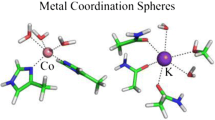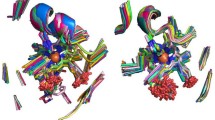Abstract
To better understand the biological significance of Ca2+, we report a comprehensive statistical analysis of calcium-binding proteins from the Protein Data Bank to identify structural parameters associated with EF-hand and non-EF-hand Ca2+-binding sites. Comparatively, non-EF-hand sites utilize lower coordination numbers (6 ± 2 vs. 7 ± 1), fewer protein ligands (4 ± 2 vs. 6 ± 1), and more water ligands (2 ± 2 vs. 1 ± 0) than EF-hand sites. The orders of ligand preference for non-EF-hand and EF-hand sites, respectively, were H2O (33.1%) > side-chain Asp (24.5%) > main-chain carbonyl (23.9%) > side-chain Glu (10.4%), and side-chain Asp (29.7%) > side-chain Glu (26.6%) > main-chain carbonyl (21.4%) > H2O (13.3%). Less formal negative charge was observed in the non-EF-hand than in the EF-hand binding sites (1 ± 1 vs. 3 ± 1). Additionally, over 20% of non-EF-hand sites had formal charge values of zero due to increased utilization of water and carbonyl oxygen ligands. Moreover, the EF-hand sites presented a narrower range of ligand distances and bond angles than non-EF-hand sites, possibly owing to the highly conserved helix–loop–helix motif. Significant differences between ligand types (carbonyl, side chain, bidentate) demonstrated that angles associated with each type must be classified separately, and the EF-hand side-chain Ca–O–C angles exhibited an unusual bimodal quality consistent with an Asp distribution that differed from the Gaussian model observed for non-EF-hand proteins. The results of this survey more accurately describe differences between EF-hand and non-EF-hand proteins and provide new parameters for the prediction and design of different classes of Ca2+-binding proteins.








Similar content being viewed by others
References
Ibers JA, Holm RH (1980) Modeling coordination sites in metallobiomolecules. Science 209(4453):223–235
Bertini I, Sigel A, Sigel H (2001) Handbook on metalloproteins, vol xxvii. Marcel Dekker, New York, p 1182
Holm RH, Kennepohl P, Solomon EI (1996) Structural and functional aspects of metal sites in biology. Chem Rev 96(7):2239–2314
Tainer JA, Roberts VA, Getzoff ED (1992) Protein metal-binding sites. Curr Opin Biotechnol 3(4):378–387
Glusker JP (1991) Structural aspects of metal liganding to functional groups in proteins. Adv Protein Chem 42:1–76
Silva JRRFd, Williams RJP (1991) The biological chemistry of the elements: the inorganic chemistry of life, vol xxi. Clarendon Press/Oxford University Press, Oxford/New York, p 561
Lippard SJ, Berg JM (1994) Principles of bioinorganic chemistry, vol xvii. University Science Books, Mill Valley, p 411
Yamashita MM et al (1990) Where metal ions bind in proteins. Proc Natl Acad Sci USA 87(15):5648–5652
Bagley SC, Altman RB (1995) Characterizing the microenvironment surrounding protein sites. Protein Sci 4(4):622–635
Dudev T, Lim C (2003) Principles governing Mg, Ca, and Zn binding and selectivity in proteins. Chem Rev 103(3):773–787
Babu CS et al (2003) A combined experimental and theoretical study of divalent metal ion selectivity and function in proteins: application to E. coli ribonuclease H1. J Am Chem Soc 125(31):9318–9328
Dudev T, Lim C (2007) Effect of carboxylate-binding mode on metal binding/selectivity and function in proteins. Acc Chem Res 40(1):85–93
Chakrabarti P (1990) Geometry of interaction of metal ions with histidine residues in protein structures. Protein Eng 4(1):57–63
Chakrabarti P (1989) Geometry of interaction of metal ions with sulfur-containing ligands in protein structures. Biochemistry 28(14):6081–6085
Chakrabarti P (1990) Interaction of metal ions with carboxylic and carboxamide groups in protein structures. Protein Eng 4(1):49–56
Glusker JP, Lewis M, Rossi M (1994) Crystal structure analysis for chemists and biologists, vol xvii. VCH, New York, p 854
Harding MM (2001) Geometry of metal–ligand interactions in proteins. Acta Crystallogr D Biol Crystallogr 57(Pt 3):401–411
Harding MM (1999) The geometry of metal–ligand interactions relevant to proteins. Acta Crystallogr D Biol Crystallogr 55(Pt 8):1432–1443
Harding MM (2000) The geometry of metal–ligand interactions relevant to proteins. II. Angles at the metal atom, additional weak metal–donor interactions. Acta Crystallogr D Biol Crystallogr 56(Pt 7):857–867
Mann KG et al (1990) Surface-dependent reactions of the vitamin K-dependent enzyme complexes. Blood 76(1):1–16
Herzberg O, Moult J, James MN (1986) A model for the Ca2+-induced conformational transition of troponin C. A trigger for muscle contraction. J Biol Chem 261(6):2638–2644
Holmes KC et al (1990) Atomic model of the actin filament. Nature 347(6288):44–49
Carafoli E (1994) The signaling function of calcium and its regulation. J Hypertens Suppl 12(10):S47–S56
Santella L, Carafoli E (1997) Calcium signaling in the cell nucleus. FASEB J 11(13):1091–1109
Martin R (1984) Bioinorganic chemistry of calcium. In: Sigel H (ed) Metal ions in biological systems, vol 17. Marcel Dekker, New York, pp 1–49
Nelson MR, Chazin WJ (1998) An interaction-based analysis of calcium-induced conformational changes in Ca2+ sensor proteins. Protein Sci 7(2):270–282
Kuroki R et al (1989) Design and creation of a Ca2+ binding site in human lysozyme to enhance structural stability. Proc Natl Acad Sci USA 86(18):6903–6907
Tajima M et al (1976) Role of calcium ions in the thermostability of thermolysin and Bacillus subtilis var. amylosacchariticus neutral protease. Eur J Biochem 64(1):243–247
Harding MM (2004) The architecture of metal coordination groups in proteins. Acta Crystallogr D Biol Crystallogr 60(Pt 5):849–859
Marsden BJ, Shaw GS, Sykes BD (1990) Calcium binding proteins. Elucidating the contributions to calcium affinity from an analysis of species variants and peptide fragments. Biochem Cell Biol 68(3):587–601
McPhalen CA, Strynadka NC, James MN (1991) Calcium-binding sites in proteins: a structural perspective. Adv Protein Chem 42:77–144
Strynadka NC, James MN (1989) Crystal structures of the helix-loop-helix calcium-binding proteins. Annu Rev Biochem 58:951–998
Einspahr H, Cook WJ, Bugg CE (1981) Conformational flexibility in single-stranded oligonucleotides: crystal structure of a hydrated calcium salt of adenylyl-(3′–5′)-adenosine. Biochemistry 20(20):5788–5794
Harding MM (2002) Metal–ligand geometry relevant to proteins and in proteins: sodium and potassium. Acta Crystallogr D Biol Crystallogr 58(Pt 5):872–874
Pidcock E, Moore G (2001) Structural characteristics of protein binding sites for calcium and lanthanide ions. J Biol Inorg Chem 6:479–489
Yang JJ, Yang W (2005) In: King RB (ed) Encyclopedia of inorganic chemistry, 2nd edn. Wiley, New York
Harding MM (2006) Small revisions to predicted distances around metal sites in proteins. Acta Crystallogr D Biol Crystallogr 62(Pt 6):678–682
Einspahr H, Bugg CE (1984) Crystal structure studies of calcium complexes and implications for biological systems. In: Sigel H (ed) Calcium and its role in biology, vol xxiii. M. Dekker, New York, p 532
Swain AL, Kretsinger RH, Amma EL (1989) Restrained least squares refinement of native (calcium) and cadmium-substituted carp parvalbumin using X-ray crystallographic data at 1.6-A resolution. J Biol Chem 264(28):16620–16628
Vyas MN, Jacobson BL, Quiocho FA (1989) The calcium-binding site in the galactose chemoreceptor protein. Crystallographic and metal-binding studies. J Biol Chem 264(34):20817–20821
Hill E et al (2001) Cadherin superfamily proteins in Caenorhabditis elegans and Drosophila melanogaster. J Mol Biol 305(5):1011–1024
Truong K, Ikura M (2002) The cadherin superfamily database. J Struct Funct Genomics 2(3):135–143
Kretsinger RH, Nockolds CE (1973) Carp muscle calcium-binding protein. II. Structure determination and general description. J Biol Chem 248(9):3313–3326
Zhou Y et al (2006) Prediction of EF-hand calcium-binding proteins and analysis of bacterial EF-hand proteins. Proteins 65(3):643–655
Nelson MR, Chazin WJ (1997) The EF-Hand Calcium-Binding Proteins Data Library
Yap KL et al (2000) Calmodulin target database. J Struct Funct Genomics 1(1):8–14
Kawasaki H, Nakayama S, Kretsinger RH (1998) Classification and evolution of EF-hand proteins. Biometals 11(4):277–295
Andreini C, Bertini I, Rosato A (2004) A hint to search for metalloproteins in gene banks. Bioinformatics 20(9):1373–1380
Reeves GA, Thornton JM (2006) Integrating biological data through the genome. Hum Mol Genet 15(Spec No 1):R81–R87
Dupont CL et al (2006) Modern proteomes contain putative imprints of ancient shifts in trace metal geochemistry. Proc Natl Acad Sci USA 103(47):17822–17827
Passerini A et al (2007) Predicting zinc binding at the proteome level. BMC Bioinformatics 8:39
Dudev T et al (2003) First–second shell interactions in metal binding sites in proteins: a PDB survey and DFT/CDM calculations. J Am Chem Soc 125(10):3168–3180
Nayal M, Di Cera E (1994) Predicting Ca2+-binding sites in proteins. Proc Natl Acad Sci USA 91(2):817–821
Deng H et al (2006) Predicting calcium-binding sites in proteins—a graph theory and geometry approach. Proteins 64(1):34–42
Thompson JD, Higgins DG, Gibson TJ (1994) CLUSTAL W: improving the sensitivity of progressive multiple sequence alignment through sequence weighting, position-specific gap penalties and weight matrix choice. Nucleic Acids Res 22(22):4673–4680
Page RD (1996) TreeView: an application to display phylogenetic trees on personal computers. Comput Appl Biosci 12(4):357–358
Murzin AG et al (1995) SCOP: a structural classification of proteins database for the investigation of sequences and structures. J Mol Biol 247(4):536–540
Falke JJ et al (1994) Molecular tuning of ion binding to calcium signaling proteins. Q Rev Biophys 27(3):219–290
Yang W et al (2002) Structural analysis, identification, and design of calcium-binding sites in proteins. Proteins 47(3):344–356
Yang W, Jones LM, Isley L, Ye Y, Lee HW, Wilkins AL, Liu Z, Hellinga HW, Malchow R, Ghazi M, Yang JJ (2003) Rational design of a calcium-binding protein. J Am Chem Soc 125:6165–6171
Cheng Y et al (2004) Crystallographic identification of Ca2+ and Sr2+ coordination sites in synaptotagmin I C2B domain. Protein Sci 13(10):2665–2672
Korndorfer IP, Brueckner F, Skerra A (2007) The crystal structure of the human (S100A8/S100A9)2 heterotetramer, calprotectin, illustrates how conformational changes of interacting alpha-helices can determine specific association of two EF-hand proteins. J Mol Biol 370(5):887–898
Tanaka Y et al (2007) Structural and mutational analyses of Drp35 from Staphylococcus aureus: a possible mechanism for its lactonase activity. J Biol Chem 282(8):5770–5780
Brux C et al (2006) The structure of an inverting GH43 beta-xylosidase from Geobacillus stearothermophilus with its substrate reveals the role of the three catalytic residues. J Mol Biol 359(1):97–109
Vallee F et al (1998) Barley alpha-amylase bound to its endogenous protein inhibitor BASI: crystal structure of the complex at 1.9 A resolution. Structure 6(5):649–659
Honig B, Nicholls A (1995) Classical electrostatics in biology and chemistry. Science 268(5214):1144–1149
Rocchia W, Alexov E, Honig B (2001) Extending the applicability of the nonlinear Poisson–Boltzmann equation: multiple dielectric constants and multivalent ions. J Phys Chem B 105(28):6507–6514
Yang AS et al (1993) On the calculation of pk(a)s in proteins. Proteins Structure Function Genetics 15(3):252–265
Gilson MK, Honig B (1988) Calculation of the total electrostatic energy of a macromolecular system: solvation energies, binding energies, and conformational analysis. Proteins 4(1):7–18
Nicholls A, Honig B (1991) A rapid finite difference algorithm, utilizing successive over-relaxation to solve the Poisson–Boltzmann equation. J Comp Chem 12:435–445
Wenk M et al (1999) The domains of protein S from Myxococcus xanthus: structure, stability and interactions. J Mol Biol 286(5):1533–1545
Linse S et al (1988) The role of protein surface charges in ion binding. Nature 335(6191):651–652
Linse S, Forsen S (1995) Determinants that govern high-affinity calcium binding. Adv Second Messenger Phosphoprotein Res 30:89–151
Vogt G, Woell S, Argos P (1997) Protein thermal stability, hydrogen bonds, and ion pairs. J Mol Biol 269(4):631–643
Jones LM et al (2008) Rational design of a novel calcium-binding site adjacent to the ligand-binding site on CD2 increases its CD48 affinity. Protein Sci 17(3):439–449
Maniccia AW et al (2006) Using protein design to dissect the effect of charged residues on metal binding and protein stability. Biochemistry 45(18):5848–5856
Acknowledgments
We would like to thank Yubin Zhou, Kun Zhao, and other members of J.J.Y.’s laboratory for their critical review of this manuscript and helpful discussions, and Wei Yang from NIH for additional suggestions. This work is supported in part by the following grants: NIH GM081749, NIH GM 62999, and NSF MCB-0092486 to J.J.Y., and DMS-0500951 to G.C.
Author information
Authors and Affiliations
Corresponding author
Additional information
Michael Kirberger, Xue Wang, and Hai Deng contributed equally to this article.
Electronic supplementary material
Below is the link to the electronic supplementary material.
Rights and permissions
About this article
Cite this article
Kirberger, M., Wang, X., Deng, H. et al. Statistical analysis of structural characteristics of protein Ca2+-binding sites. J Biol Inorg Chem 13, 1169–1181 (2008). https://doi.org/10.1007/s00775-008-0402-7
Received:
Accepted:
Published:
Issue Date:
DOI: https://doi.org/10.1007/s00775-008-0402-7




